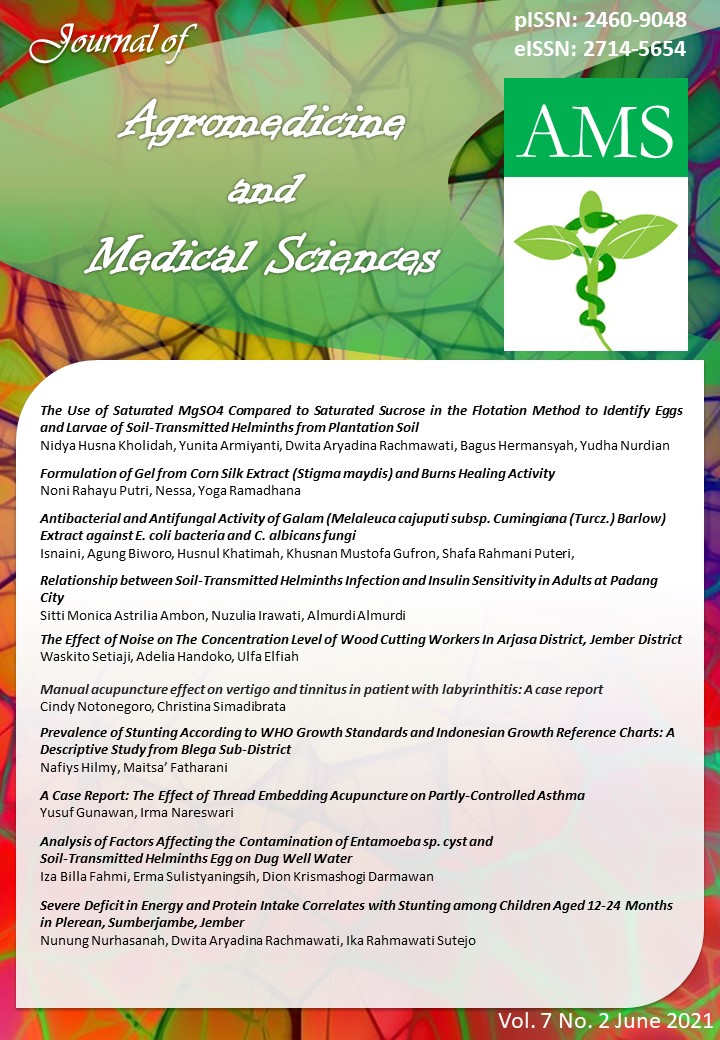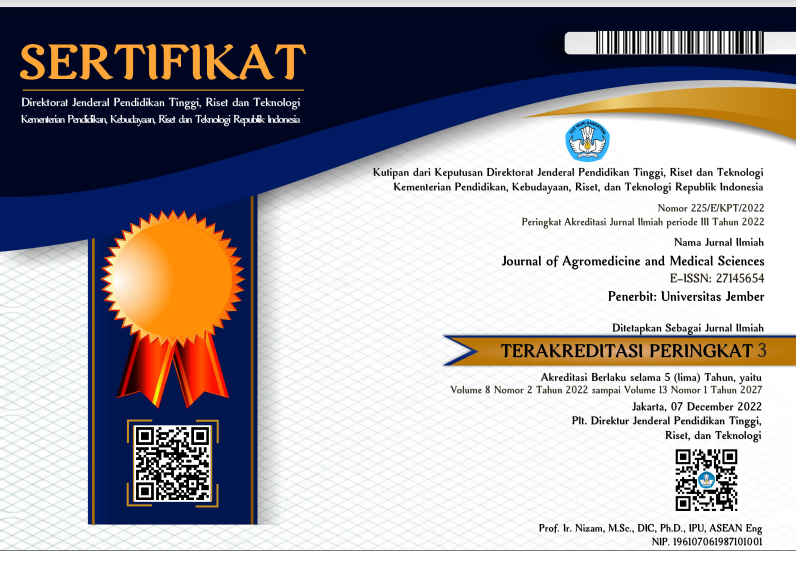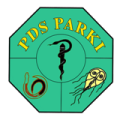Antibacterial and Antifungal Activity of Galam (Melaleuca cajuputi subsp. Cumingiana (Turcz.) Barlow) Extract against E. coli bacteria and C. albicans fungi
DOI:
https://doi.org/10.19184/ams.v7i2.23467Abstract
Galam (Melaleuca cajuputi subsp. Cumingiana (Turcz.) Barlow) is a peat swamp forest plant. This plant is used to treat respiratory diseases, colitis, sore throat, itchy skin, diarrhea, and dizziness. This study aimed to analyze the antibacterial and antifungal activity of the methanol extract of M. cajuputi subsp. Cumingiana (Turcz.) Barlow flowers and fruit against Escherichia coli and Candida albicans bacteria. This research is a pretest-posttest research with control group design and consists of 3 stages of research. The first stage is the phytochemical screening test, the second stage determines the minimum inhibitory concentration (MIC) and the third determines the minimum bactericidal concentration (MBC). The results showed that the methanol extract of M. cajuputi subsp. Cumingiana (Turcz.) Barlow flowers and fruit contained terpenoids, flavonoids, phenols, saponins, quinones, steroids, tannins, while alkaloid compounds only found in the methanol extract of M. cajuputi subsp. Cumingiana (Turcz.) Barlow fruit. The MIC and MBC values ​​of M. cajuputi subsp. Cumingiana (Turcz.) Barlow flower methanol extract against E. coli were 1.67 and 2.083 mg/mL, respectively, while the MIC and MBC values ​​of the methanol extract of M. cajuputi subsp. Cumingiana (Turcz.) Barlow flower against C. albicans were 3.125 and 25 mg/mL. The MIC and MBC values ​​of the methanol extract of M. cajuputi subsp. Cumingiana (Turcz.) Barlow fruit against E. coli have same value were 3.334 mg/mL, while the MIC and MBC values ​​of the methanol extract of M. cajuputi subsp. Cumingiana (Turcz.) Barlow fruit against C. albicans were 3.125 and 12.5 mg/mL, respectively.
Keywords: Galam antibacterial, antifungal, Escherichia coli, Candida albicans
Downloads
References
Azis. (2019). Analisis in vitro aktivitas antibakteri daun sisik naga (Drymoglossum pilosellaoides) terhadap bakteri Vibrio harveyi dan Vibrio parahaemolyticus. Journal of Aquaculture and Fish Health, 8(2), 86–91. https://doi.org/http://dx.doi.org/10.20473/jafh.v8i2.11984
Bharat, C.S., Praveen, D. (2016). Evaluation of in vitro antimicrobial potential and phytochemical analysis of Spruce, Cajeput and Jamrosa Essential Oil against clinical isolates, International Journal of Green Pharmacy, 10(1), 27–32.
Cushnie T.P.T., Cushnie, B., Lamb, A. . (2014). Alkaloids: an overview of their antibacterial, antibiotic-enhancing and antivirulence activities. International Journal of Antimicrobial Agents, 44, 377–386. https://doi.org/http://dx.doi.org/10.1016/j.ijantimicag.2014.06.001
Kawengian, S. A. F., Wuisan, J., & Leman, M. A. (2017). Uji daya hambat ekstrak daun serai (Cymbopogon citratus L) terhadap pertumbuhan Streptococcus mutans. E-GIGI, 5(1), 1–5. https://doi.org/10.35790/eg.5.1.2017.14736
Kemegne, G. A., Mkounga, P., Essia Ngang, J. J., Sado Kamdem, S. L., & Nkengfack, A. E. (2017). Antimicrobial structure activity relationship of five anthraquinones of emodine type isolated from Vismia laurentii. BMC Microbiology, 17(1), 1–8. https://doi.org/10.1186/s12866-017-0954-1
Kueh, B.W.B., Yusup, S., Osman, N., Hafizah, N. (2019). Analysis of Melaleuca cajuputi extract as the potential herbicides for paddy weeds. Sustainable Chemistry and Pharmacy, 11, 36–40. https://doi.org/https://doi.org/10.1016/j.scp.2018.12.004
Kueh, B.W.B., Yusup, S., Osman, N. (2018). Supercritical carbon dioxide extraction of Melaleuca cajuputi leaves for herbicides allelopathy: Optimization and kinetics modelling. Journal of CO2 Utilization, 24, 220–227. https://doi.org/10.1016/j.jcou.2018.01.005
Nazeh M. Al-Abd, Z. M. N., Mansor, M., Azhar, F., & Kassim, M. S. H. and M. (2015). Antioxidant, antibacterial activity, and phytochemical characterization of Melaleuca cajuputi extract. BMC Complementary and Alternative Medicine, 15(1), 1–13. https://doi.org/https://doi.org/10.1186/s12906-015-0914-y
Ngazizah, F. N., Ekowati, N., & Septiana, A. T. (2017). Potensi Daun Trembilungan (Begonia hirtella Link) sebagai Antibakteri dan Antifungi. Biosfera, 33(3), 126. https://doi.org/10.20884/1.mib.2016.33.3.309
Paosen, S., Saising, J., Wira Septama, A., & Piyawan Voravuthikunchai, S. (2017). Green synthesis of silver nanoparticles using plants from Myrtaceae family and characterization of their antibacterial activity. Materials Letters, 209, 201–206. https://doi.org/10.1016/j.matlet.2017.07.102
Rijayanti, R. (2014). Uji Aktivitas antibakteri ekstrak etanol daun mangga bacang (Mangifera foetida L.) terhadap Staphylococcus aureus secara in vitro. (Skripsi). Universitas Tanjungpura : Pontianak.
Rollando, R. (2019). Uji antimikroba minyak atsiri masoyi (Massoia aromatica) terhadap bakteri Streptococcus mutans. Majalah Farmasi Dan Farmakologi, 23(2), 52–57. https://doi.org/10.20956/mff.v23i2.6585
Sapara, T. U., & Waworuntu, O. (2016). Efektivitas antibakteri ekstrak daun pacar air (Impatiens Balsamina L.) terhadap pertumbuhan Porphyromonas Gingivalis. Pharmacon, 5(4), 10–17. https://doi.org/10.35799/pha.5.2016.13968
Solihah, M. A., Rosli, W. W. I., & Nurhanan, A. R. (2012). Phytochemicals screening and total phenolic content of Malaysian Zea mays hair extracts. International Food Research Journal, 19(4), 1533–1538.
Tiwari, P., Kumar, B., Kaur, M., Kaur, G. and Kaur, H. (2011). Phytochemical screening and extraction: A review. Internationale Pharmaceutica Sciencia, 1(1), 98–106.
Wahdaningsih, S., Untari, E. K., & Fauziah, Y. (2014). Antibakteri fraksi n-Heksana kulit Hylocereus polyrhizus terhadap Staphylococcus epidermidis dan Propionibacterium acnes. Pharmaceutical Sci. Pharmaceutical Sciences and Research, 1(3), 180–193. http://dx.doi.org/10.7454/psr.v1i3.3490
Wardhani, R. R. A. A. K., Akhyar, O., & Prasiska, E. (2018). Skrining fitokimia, aktivitas antioksidan, dan kadar total fenol-flavonoid ekstrak daun dan buah tanaman galam rawa Gambut (Melaleuca cajuputi ROXB ). Jurnal Inovasi Pendidikan Sains, 9(2), 133–143.
Warokka, K. E., Wuisan, J., & . J. (2016). Uji konsentrasi hambat minimum (KHM) ekstrak daun binahong (Anredera cordifolia Steenis) sebagai antibakteri terhadap pertumbuhan Streptococcus mutans. E-GIGI, 4(2). https://doi.org/10.35790/eg.4.2.2016.13766






















